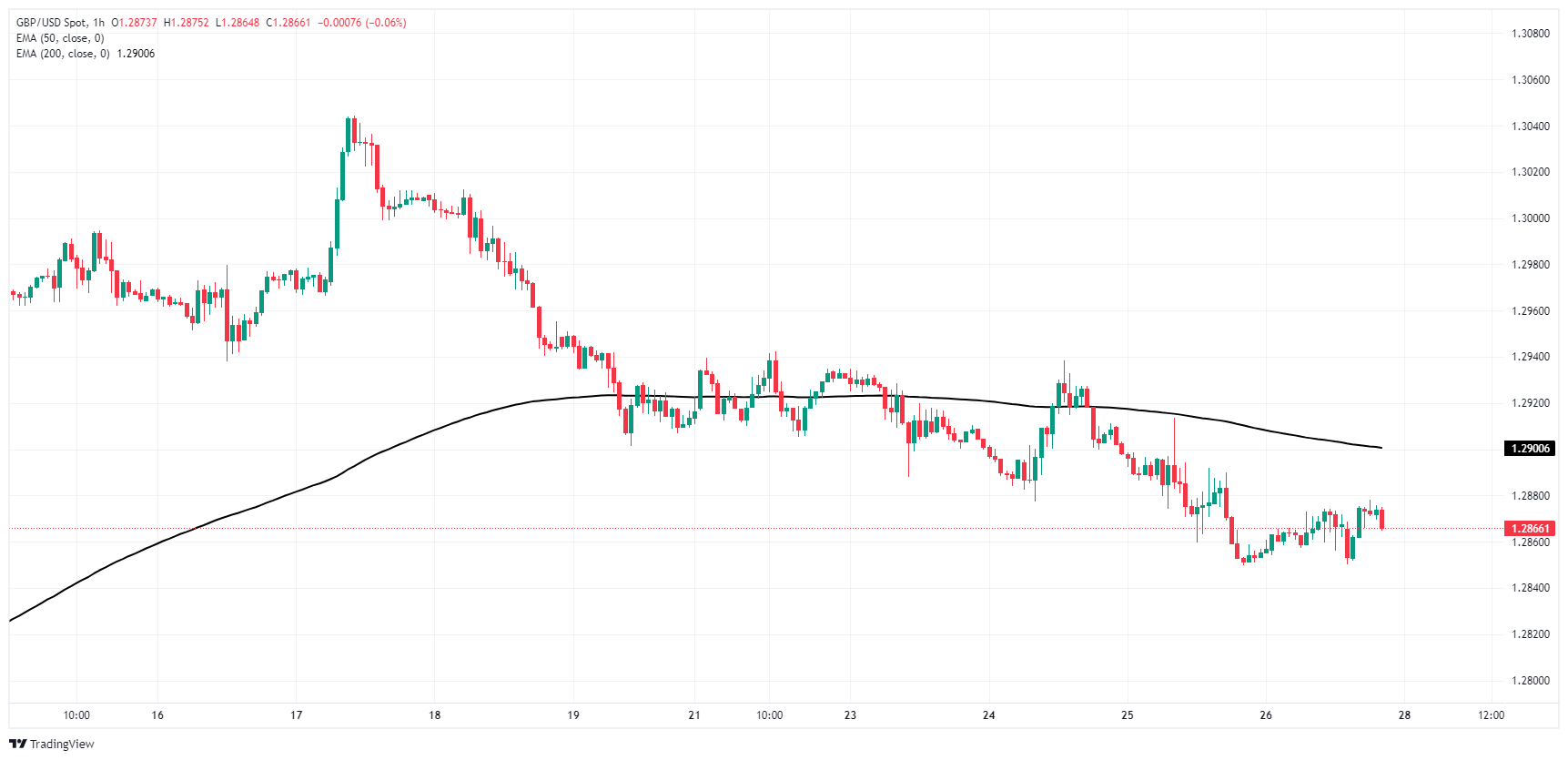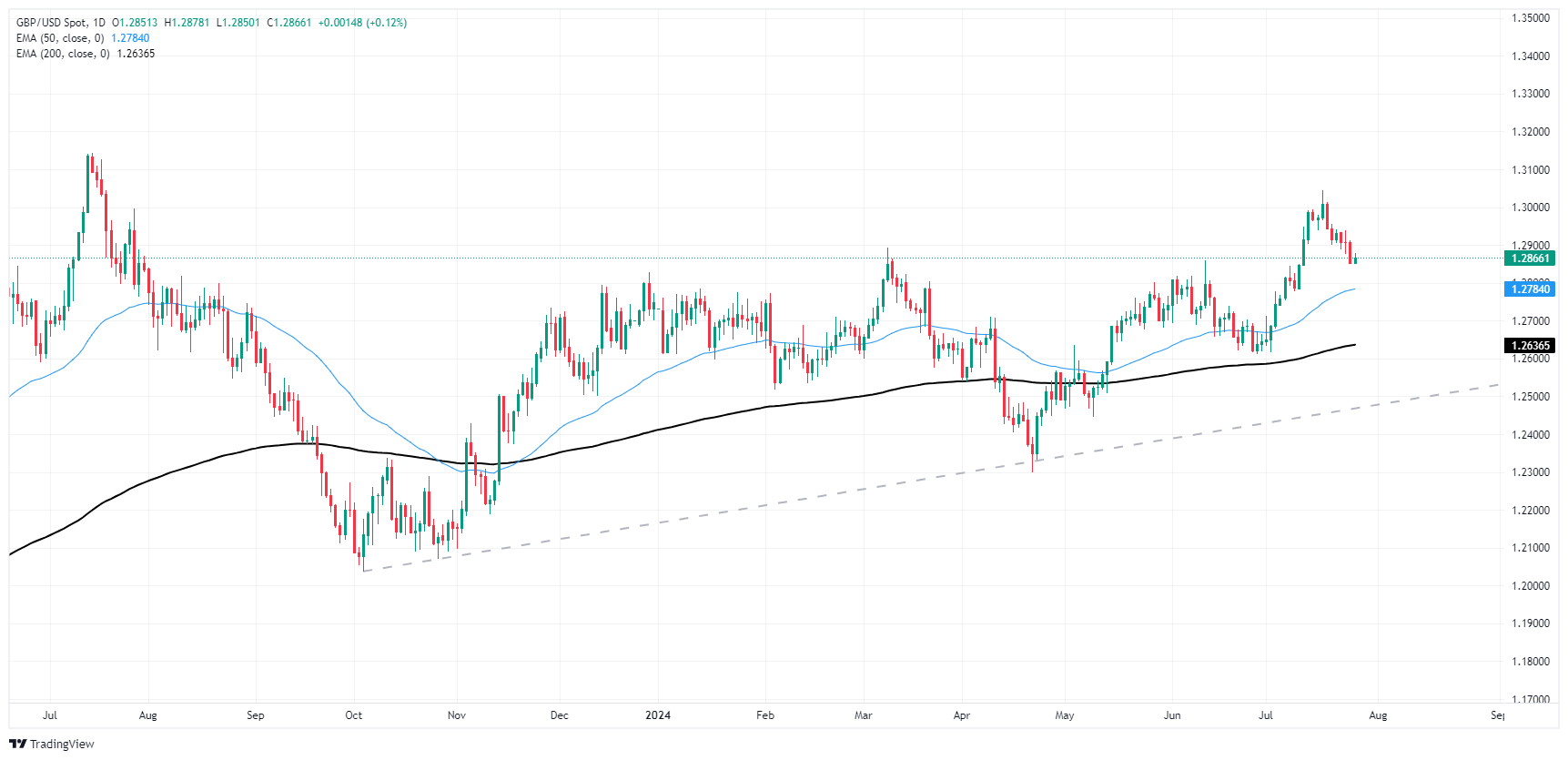- Analytics
- News and Tools
- Market News
- GBP/USD chalks in another down week despite late Sterling uptick
GBP/USD chalks in another down week despite late Sterling uptick
- GBP/USD failed to make meaningful headway on Friday.
- The Pound Sterling has been floundering ahead of next BoE rate call.
- BoE set to deliver a quarter-point rate cut next Thursday.
GBP/USD floundered on Friday, climbing a scant 0.13% on the day as the Pound Sterling gets weighed down by broad-market expectations of a rate cut from the Bank of England (BoE) next week. The pair wraps up the trading week down one-half of one percent, adding a second straight week of downside momentum as the pair pulls back from last week’s 12-month high above 1.3000.
Forecasting the Coming Week: All eyes are on the Fed’s decision and the NFP
The BoE is set to deliver its first rate cut since March 2020 on Thursday. The UK’s main benchmark rate is expected to shift down 25 basis points to 5.0% from the current 5.25%. Before that, the Federal Reserve (Fed) is due to deliver its own July rate call, and investors are broadly expecting the US central bank to keep rates pinned for one more meeting before kicking off a rate-cutting cycle in September.
The core US PCE inflation remained steady at 2.6% year-over-year in June, going against the median market forecast of a decrease to 2.5%. Additionally, near-term PCE inflation accelerated month-over-month in June, increasing to 0.2% from the forecasted 0.1%.
The University of Michigan's Consumer Sentiment Index dropped to an eight-month low of 66.4 in July, less than the anticipated 66.0 but still lower than the previous reading of 68.4. The UoM 5-year Consumer Inflation Expectations also rose to 3.0% in July from the previous 2.9%.
Despite indications of potential inflationary pressures, the markets chose not to worry about the figures and instead shifted towards a risk-on sentiment, holding out hope for a rate cut in September. According to the CME's FedWatch Tool, rate markets are still pricing in at least a 25-basis-point rate cut by the Federal Open Market Committee (FOMC) on September 18, with 100% odds of a hold on July 31. Additionally, there is a 12% chance of a 50-bps double cut in September by a contingent that is particularly hopeful for a rate cut.
British Pound PRICE This week
The table below shows the percentage change of British Pound (GBP) against listed major currencies this week. British Pound was the strongest against the Australian Dollar.
| USD | EUR | GBP | JPY | CAD | AUD | NZD | CHF | |
|---|---|---|---|---|---|---|---|---|
| USD | 0.24% | 0.36% | -2.29% | 0.87% | 2.11% | 2.20% | -0.44% | |
| EUR | -0.24% | 0.10% | -2.55% | 0.58% | 1.90% | 1.87% | -0.74% | |
| GBP | -0.36% | -0.10% | -2.75% | 0.46% | 1.80% | 1.76% | -0.88% | |
| JPY | 2.29% | 2.55% | 2.75% | 3.27% | 4.57% | 4.52% | 1.80% | |
| CAD | -0.87% | -0.58% | -0.46% | -3.27% | 1.32% | 1.30% | -1.32% | |
| AUD | -2.11% | -1.90% | -1.80% | -4.57% | -1.32% | -0.03% | -2.63% | |
| NZD | -2.20% | -1.87% | -1.76% | -4.52% | -1.30% | 0.03% | -2.56% | |
| CHF | 0.44% | 0.74% | 0.88% | -1.80% | 1.32% | 2.63% | 2.56% |
The heat map shows percentage changes of major currencies against each other. The base currency is picked from the left column, while the quote currency is picked from the top row. For example, if you pick the British Pound from the left column and move along the horizontal line to the US Dollar, the percentage change displayed in the box will represent GBP (base)/USD (quote).
GBP/USD technical outlook
Cable has fallen back below the 1.2900 handle after backsliding from a 12-month peak near 1.3045 set last week. The pair is down around 1.5% peak-to-trough, but near-term momentum still leans in favor of buyers as price action holds on the high side of the 200-day Exponential Moving Average (EMA) at 1.2636.
Short pressure will be looking to force bids down below the last swing low near 1.2600, while renewed bidding could step in if GBP/USD declines far enough to tap a rising trendling drawn from last October’s bottom bids near 1.2037.
GBP/USD hourly chart
GBP/USD daily chart
Pound Sterling FAQs
The Pound Sterling (GBP) is the oldest currency in the world (886 AD) and the official currency of the United Kingdom. It is the fourth most traded unit for foreign exchange (FX) in the world, accounting for 12% of all transactions, averaging $630 billion a day, according to 2022 data. Its key trading pairs are GBP/USD, aka ‘Cable’, which accounts for 11% of FX, GBP/JPY, or the ‘Dragon’ as it is known by traders (3%), and EUR/GBP (2%). The Pound Sterling is issued by the Bank of England (BoE).
The single most important factor influencing the value of the Pound Sterling is monetary policy decided by the Bank of England. The BoE bases its decisions on whether it has achieved its primary goal of “price stability” – a steady inflation rate of around 2%. Its primary tool for achieving this is the adjustment of interest rates. When inflation is too high, the BoE will try to rein it in by raising interest rates, making it more expensive for people and businesses to access credit. This is generally positive for GBP, as higher interest rates make the UK a more attractive place for global investors to park their money. When inflation falls too low it is a sign economic growth is slowing. In this scenario, the BoE will consider lowering interest rates to cheapen credit so businesses will borrow more to invest in growth-generating projects.
Data releases gauge the health of the economy and can impact the value of the Pound Sterling. Indicators such as GDP, Manufacturing and Services PMIs, and employment can all influence the direction of the GBP. A strong economy is good for Sterling. Not only does it attract more foreign investment but it may encourage the BoE to put up interest rates, which will directly strengthen GBP. Otherwise, if economic data is weak, the Pound Sterling is likely to fall.
Another significant data release for the Pound Sterling is the Trade Balance. This indicator measures the difference between what a country earns from its exports and what it spends on imports over a given period. If a country produces highly sought-after exports, its currency will benefit purely from the extra demand created from foreign buyers seeking to purchase these goods. Therefore, a positive net Trade Balance strengthens a currency and vice versa for a negative balance.
© 2000-2025. All rights reserved.
This site is managed by Teletrade D.J. LLC 2351 LLC 2022 (Euro House, Richmond Hill Road, Kingstown, VC0100, St. Vincent and the Grenadines).
The information on this website is for informational purposes only and does not constitute any investment advice.
The company does not serve or provide services to customers who are residents of the US, Canada, Iran, The Democratic People's Republic of Korea, Yemen and FATF blacklisted countries.
Making transactions on financial markets with marginal financial instruments opens up wide possibilities and allows investors who are willing to take risks to earn high profits, carrying a potentially high risk of losses at the same time. Therefore you should responsibly approach the issue of choosing the appropriate investment strategy, taking the available resources into account, before starting trading.
Use of the information: full or partial use of materials from this website must always be referenced to TeleTrade as the source of information. Use of the materials on the Internet must be accompanied by a hyperlink to teletrade.org. Automatic import of materials and information from this website is prohibited.
Please contact our PR department if you have any questions or need assistance at pr@teletrade.global.















